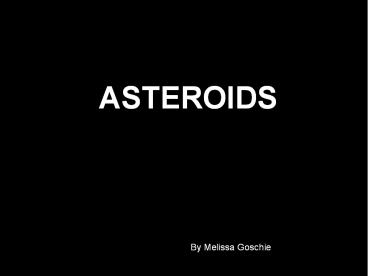ASTEROIDS - PowerPoint PPT Presentation
Title:
ASTEROIDS
Description:
ASTEROIDS By Melissa Goschie What is an asteroid? Rocky-metallic objects Range in size from about the size of pebbles to around 600 miles (~1,000 km) across. – PowerPoint PPT presentation
Number of Views:164
Avg rating:3.0/5.0
Title: ASTEROIDS
1
ASTEROIDS
By Melissa Goschie
2
What is an asteroid?
- Rocky-metallic objects
- Range in size from about the size of pebbles to
around 600 miles (1,000 km) across. - Much smaller than planets
- Orbit the sun in an area called the Asteroid Belt
http//images.google.com/imgres?imgurlhttp//www.
indiana.edu/geol105/images/gaia_chapter_2/asteroi
ds_compare4.jpgimgrefurlhttp//www.indiana.edu/
geol105/images/gaia_chapter_2/comets_and_asteroids
.htmusg__ncFdDybfM--CIfePpk2Bu9QbSwoh775w63
0sz95hlenstart19tbnidXkPsagFZggIwcMtbnh
142tbnw115prev/images3Fq3Dasteroids26gbv3D
226hl3Den
3
History
- January 1801, Giuseppe Piazzi sees an object he
first calls a comet. Then calls it a small
planet and names it Ceres. - Ceres is the Sicilian goddess of grain
- Over next few years Pallas, Vesta and Juno are
discovered.
image http//upload.wikimedia.org/wikipedia/common
s/9/92/Giuseppe_Piazzi.jpg http//www.enchantedlea
rning.com/subjects/astronomy/asteroids/composition
.shtml
4
Where can you find them?
- In the Asteroid Belt between Mars and Jupiter.
- There are thousands of known and lots more
discovered every year. - Ceres is the largest with a diameter of 974 km
- All the asteroids put together would not even be
half of the moons mass.
http//upload.wikimedia.org/wikipedia/commons/f/f3
/InnerSolarSystem-en.png
5
How did they get there?
- There are a couple of theories about where
asteroids come from. - One is that when the planets were forming there
was material that didnt have enough mass to come
together and instead fragmented out. - Another theory is that material came from a
planet that was destroyed from a collision. - Either theory dates asteroids to the birth of our
solar system.
http//www.vredefortstructure.org/engtimeline02.ht
m
6
Terms you might want to know
- Asteroid medium-sized rocky object orbiting the
Sun smaller than a planet and larger than a
meteoroid. - Meteoroid a small rocky object orbiting the
Sun smaller than an asteroid. - Meteor a bright streak of light in the sky
caused by the entry into Earths atmosphere of a
meteoroid or a small icy particle. Very large,
bright ones are called fireballs and bolides.
(also known as a shooting star or falling
star) - Meteorite a rock of extra-terrestrial origin
found on Earth - Comet a medium-sized icy object orbiting the
Sun smaller than a planet
http//www.cosmosmagazine.com/files/imagecache/new
s/files/news/comet2.jpg
7
Classification by Type
- C-type, includes more than 75 of known
asteroids extremely dark (albedo 0.03) similar
to carbonaceous chondrite meteorites
approximately the same chemical composition as
the Sun minus hydrogen, helium and other
volatiles - S-type, 17 relatively bright (albedo .10-.22)
metallic nickel-iron mixed with iron- and
magnesium-silicates - M-type, most of the rest bright (albedo
.10-.18) pure nickel-iron. - There are also a dozen or so other rare types
http//rocksfromspace.open.ac.uk/images/Asteroids_
Sullivan.jpg
8
Classification by Location
- The Main Belt is located between Mars and
Jupiter. - Near-Earth are ones that closely approach Earth.
- Trojan are near points of Jupiters orbit 60
degrees ahead and behind). - The gaps between asteroids in the Main Belt are
called Kirkwood Gaps. These gaps are mostly
empty regions caused from Jupiters orbit.
http//keetsa.com/blog/wp-content/uploads/2007/09/
asteroid-belt.jpg
9
Activity 1How do you know if it is a meteorite?
- http//dawn.jpl.nasa.gov/Meteorite/experiment.asp
http//www.astronomy-blog.com/images/blogs/4-2008/
meteorite-impacts.jpg
10
Comets
http//www.williamjosephgallery.com/Comet20Hale2
0Bopp20Over20Mt20Hood20Oregon20Nehl20199720
color2096x5.JPG
11
Is a comet an asteroid?
- Comets have large erratic orbits which when they
get close to the sun the ice is melted and this
forms the tail. - When the comet is completely melted, the remnant
becomes an asteroid. - Asteroids are made up of metals and rocky
material - Comets are made up of ice, dust and rocky
material. - Both asteroids and comets were formed early in
the history of the solar system about 4.5 billion
years ago. - Asteroids formed much closer to the sun, where it
was too warm for ices to remain solid. - Comets formed farther from the sun where ices
would not melt. - Comets which approach the sun loose material with
each orbit because some of their ice melts and
vaporizes to form a tail.
12
Questions to think about
- What prevents the asteroids in the belt from
plunging towards the Sun and hitting the inner
planets in the process?
13
Questions to think about
- Question
- What prevents the asteroids in the belt from
plunging towards the Sun and hitting the inner
planets in the process? - Answer
- While the Sun gravitationally pulls the asteroids
inward, the gravitational pull of Jupiter is
pulling the asteroids outward. Since the belt is
closer to Jupiter than it is to the Sun, Jupiter
exerts more of an influence on the asteroids. As
a result, the asteroids are held in orbit away
from the inner planets.
14
- Do asteroids have moons?
15
- Do asteroids have moons?
- Yes, asteroids have moons.
16
- Have any spacecraft ever landed on an asteroid?
17
- Have any spacecraft ever landed on an asteroid?
- Yes, on February 12, 2001 flight controllers
landed NASA's NEAR spacecraft on an asteroid
called Eros. NEAR was the first spacecraft to
orbit and touchdown on the surface of an
asteroid. NEAR began orbiting Eros a year
earlier, on February 14, 2000. The spacecraft
collected close up photographs and measured the
size and shape of Eros before landing. Eros is
the largest of the asteroids whose orbits cross
the orbit of the Earth.
18
Activity 2Lets make our own comet!
19
Credits































